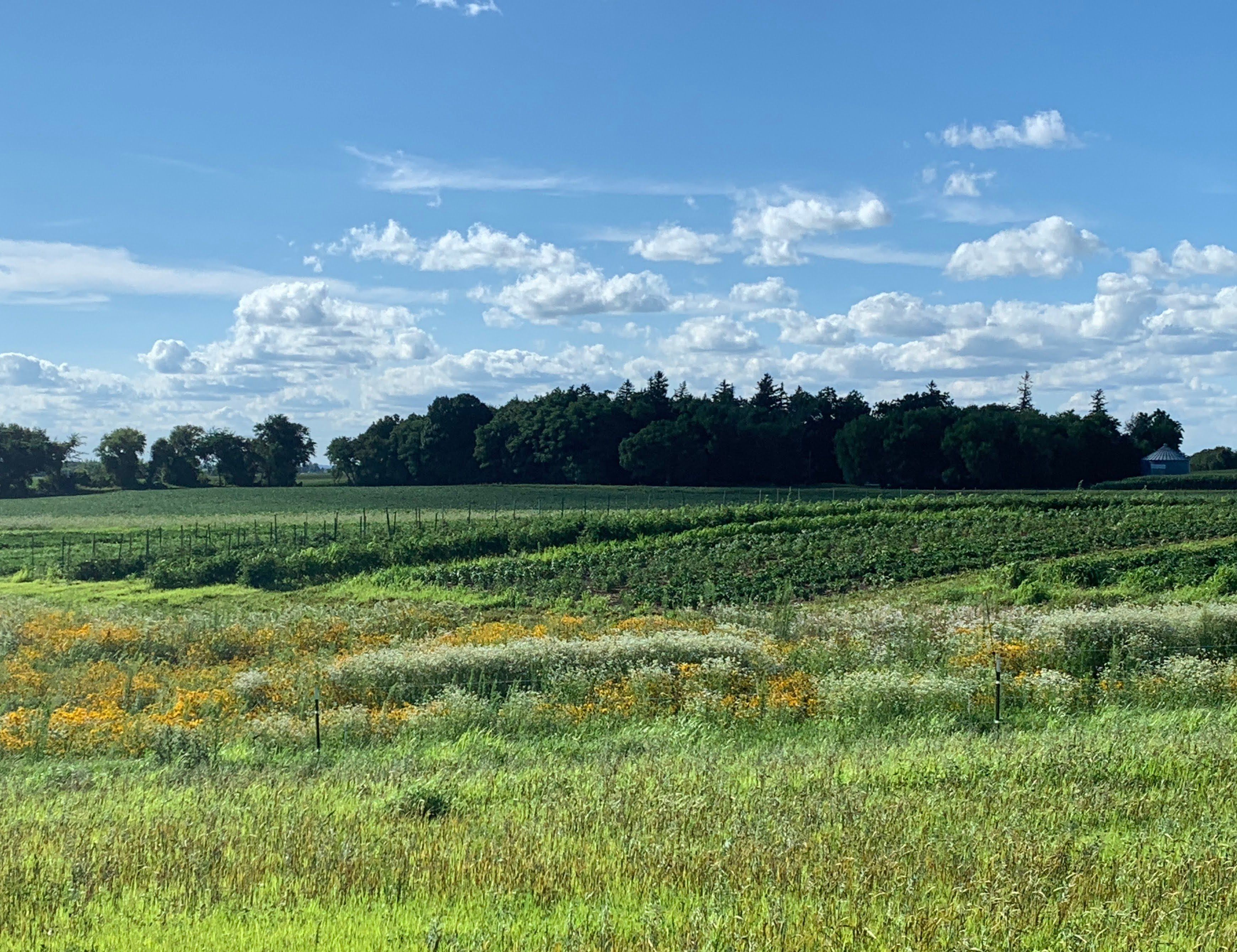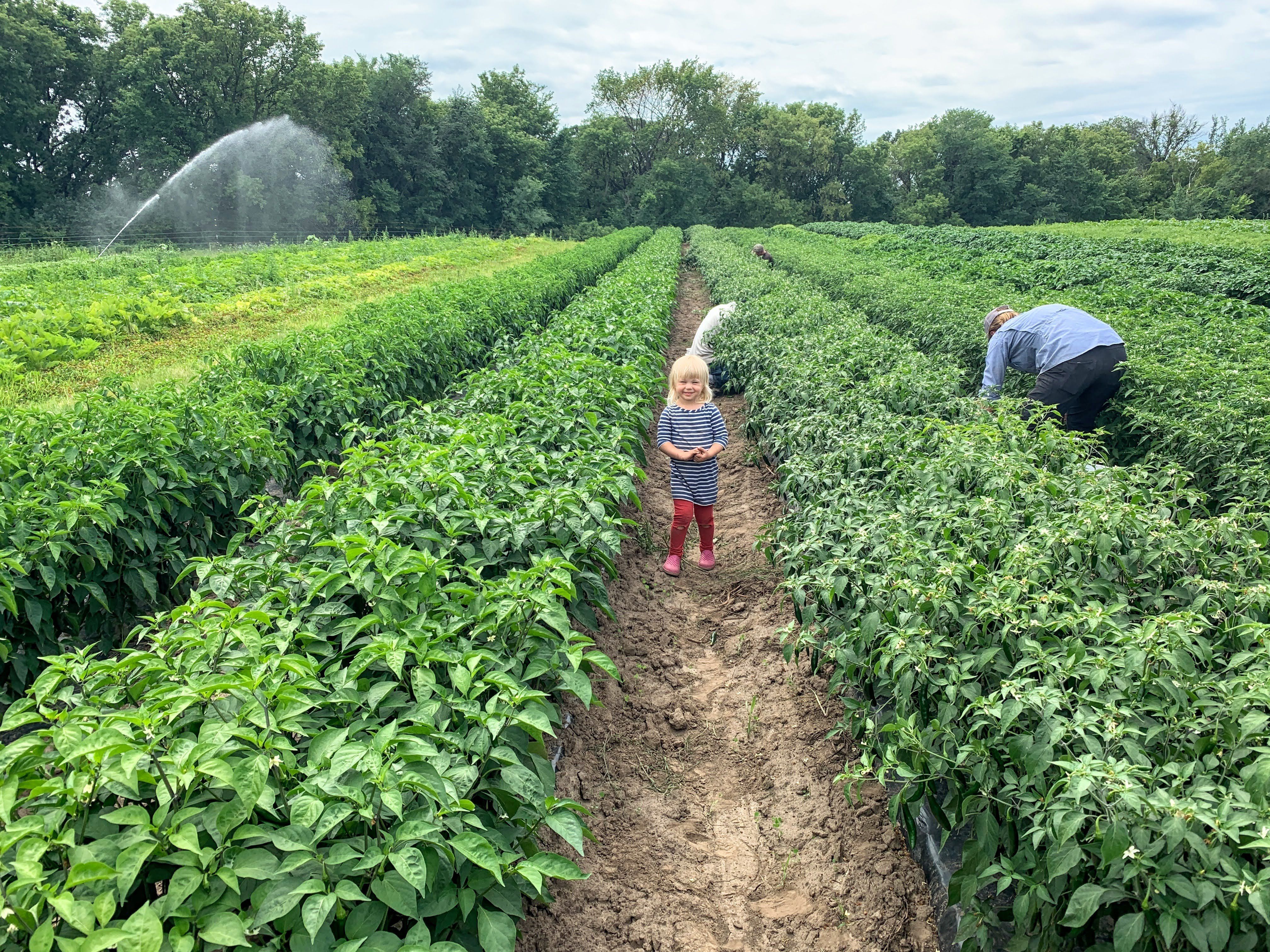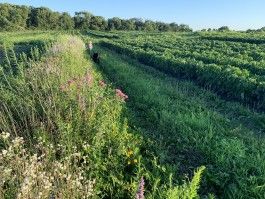Thanks to all of you who did your rain dance last Saturday - we finally got rain! And it was ideal in every way: it came fairly gently (minimal soil crusting, splashing, erosion) and in a total of just shy of 2". Plenty to recharge the topsoil after weeks of dry conditions, but not so much to cause runoff or waterlogging of soils.
We enjoyed this week of lovely sunny, warm weather. We ended the week with mass harvest of most of our onion varieties - sweet, yellow storage, cipollini, and shallots. The red storage onions take another week or so to mature, so we'll get those next week. They're all curing on our greenhouse benches with fans running nearly 24/7 to dry them down. As alluded to in a prior newsletter, the crop is smaller than prior years' due to extensive leaf feeding damage from the tiny insect pest, thrips. The leaves of the crop are nearly white and devoid of chlorophyl (and thus energy for growth) by the time we harvested them, all caused by thrips feeding. Since thrips couldn't seem to be controlled with any of the products we sprayed on them, we'll have devise more creative solutions next season. Biocontrol is one option - purchasing and releasing insects that prey upon thrips. I also know thrips can be deterred by reflective surfaces, which can be achieved by using "metallized" plastic mulch that has a metallic coating on the topside. We are really hoping to get away from plastic mulch as much as possible next year, so I'm not excited about that option, but it may be necessary.
The watermelon saga has continued. Last week, I reported we suspected coyotes were feeding on ripe watermelons. We're now thinking there could have been multiple culprits, with some damaged fruits looking more like raccoon damage. We have still yet to capture either on on our trail cam, though. The newest addition to the watermelon destroyer squad are CROWS. These have been well documented on camera pecking at fruits. Sometimes they just make a few pecks about a centimeter deep into the rind without getting through to the fruit. Other times they penetrate a couple inches into the ripe flesh. Needless to say, there seem to be fewer new large animal holes and more smaller holes from crows, so perhaps our electric perimeter fence has been somewhat successful in keeping out coyotes/raccoons. What to do about the birds? Our next tactic is install flash tape throughout our two watermelon fields. This crinkly, reflective ribbon is supposed to scare birds away. We'll put it to the test. We are planning to put watermelons in next week's boxes if we can get to some before our hungry wildlife.
In better news, tomatoes are booming right now! Not only are our smaller high tunnel plantings of cherries, slicers, and heirlooms reaching full production, but a large field planting intended for a wholesale distributor is now producing, as well. We harvested over 800 lbs of tomatoes this past week. So 'tis the season for tomato indulgence. We are offering some 10-lb cases of tomatoes as extras for members, either firsts or seconds. (Seconds just have some surface scarring and scabbing, mainly, possibly light cracking.) If you decide to order, note that they will be packed in separate cardboard boxes, so those will be stacked separately from the plastic farm share boxes. Be sure to grab yours.
Crew Bios
Sarah has been writing crew bios, but she had a very busy week, so I'm going to take over this week and write about her!
Sarah joined our farm team in spring of 2019 after working on vegetable farms out east for the prior 6-7 years. She was hired as our Farmers' Market Lead, and her prior role in 2019 was coordinating wash/pack of produce for the farmers' market, then managing the market itself every Saturday and Sunday. She was the one who woke up at 3:00 am to get the truck up to St. Paul and set up for market. As we segued to winter, we launched a small winter CSA program, and she managed that throughout the winter months.
This year brought many changes as we adapted to the pandemic, so we aren't attending the farmers' market. She has taken on a "postharvest manager" role, although she still helps with harvesting and other field tasks in certain days. She's at the helm of all the postharvest work for farm shares: cold storage, washing, quality control, bagging, and packing of shares. In fact, as I (Dana) became particularly distracted with irrigation issues in July, I trusted Sarah (with help from Rachel on field harvest) to take care of all prep for farm share each week. We had a meeting Monday morning to discuss our harvest list, then I came back on Wednesday afternoon to help with packing of shares. Everything got done while I was attending to other matters. Sarah's leadership has been so central to our successful pivot to this customizable farm share model - we are so thankful to have her on the team!
And she's been helping manage our deer pest problems, to boot! Last Tuesday, after we received a shooting permit from the DNR to control deer feeding on our crops, Sarah successfully took a doe that had been documented feeding on our sweet potatoes nightly for who knows how long. She spent all night processing the deer and showed up Wednesday morning after one hour of sleep with a smile on her face.
Sarah's favorite vegetable is kale, although she's having a fling with Fairy Tale eggplant right now. "It's really good grilled and put on pizza."
Notes on items in this week's share
- We started picking cantaloupe this week, and every one I've eaten has been delicious. The fairly dry weather is good for sugar accumulation in fruits like melons. We grow two varieties: Athena, a standard full-size (4-5 lb) melon; and Sugar Cube, a half-size personal sized melon known for its sweetness. Folks receiving melon this week will be getting either one large or two small fruits. Most will be ripe and ready to eat. It's possible some that we pick on Wednesday right before packing will be almost ripe. If you see a greenish/blueish tinge rather than solid yellow color, give it a day or two in a cool but not cold spot in your kitchen.
- Cucumbers - same story as the last couple weeks. There may be small amounts of cucumber beetle damage to the skin - just peel it off and it shouldn't be an issue. We do suspect this reduces the shelf life a bit, so best to eat sooner than later. Our first planting has had some production issues and is almost done, so we may have a couple week gap without cukes.
- Garlic is pretty much cured. Should be fine stored at room temperature. Hardneck garlic has fewer, larger cloves compared with standard supermarket softneck types.
- Green beans are abundant again this week - our crew will have spent a collective 25 hours picking beans for this week's shares. Yes, beans are a major labor sink when in season... They've been coming in dirty after last weekend's rain, so we have been rinsing them, but there may still be some soil to wash off at home.
- Tomatoes of all types should be pretty much ripe and ready to eat. Still refer to Sarah's "tomato guide" from the newsletter a couple weeks ago if you have questions on a particular variety's ripeness.
- Basil this week is coming from a planting on bare soil (rather than plasticulture or high tunnel) which exposes it more to soil splash. There'll be a bit of soil on some leaves, but we do not wash basil because it greatly compromises storage. Just rinse before use.
Have a great week!
Dana




